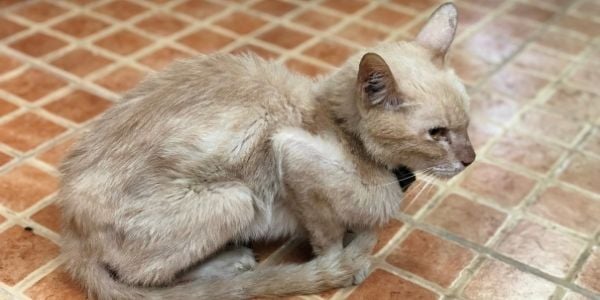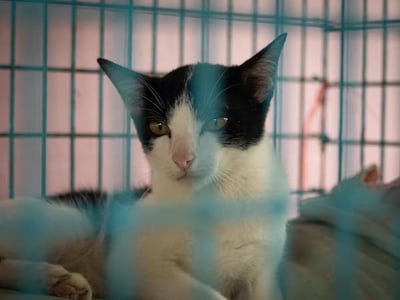- en
Hyperthyroidism is a serious condition, so veterinary care is necessary. The good news is that many cats do really well when treated and don't feel that bad during the process.
This InfoRx will help you know what hyperthyroidism is and how it can be managed.
Quick Links

Hyperthyroidism didn't emerge until the 1980s. But since that time, because it is such a common disease in cats, much information has become available. An interesting fact, which suggests there may be a genetic factor at work, is that purebred cats (like Siamese, Burmese, Persian, Abyssinian, and Himalayan) appear to have a lower incidence of this disease.
Our mission is to help save dogs' and cats’ lives through our educational content. To support our efforts, this page may contain affiliate links. We earn a commission for qualifying purchases – at no cost to you.
The most common hormonal imbalance in cats is hyperthyroidism, which is an overactive thyroid. The thyroid comprises two glands located in your cat’s neck, and it produces hormones (known as thyroxine) that impact your cat’s normal body functions. Nearly all the organs in the body are affected by thyroid hormones. Included in this are:
Since thyroid hormones increase the metabolic rate, cats with hyperthyroidism have a drastically increased energy demand and energy consumption. The initial symptoms can be mild to start but progress with the disease. Some of the following signs of hyperthyroidism are:
In order to determine if your cat has hyperthyroidism, your veterinarian will perform a physical exam, especially of your cat’s neck, to see if the thyroid gland is enlarged. The vast majority of hyperthyroidism cases in cats occur because of a harmless growth of cells to either one or both glands.
Your veterinarian will likely also order bloodwork and a urinalysis. They need to have a thyroid panel done to determine if there is an elevation in the thyroid hormones. Additional bloodwork is needed to evaluate the liver and kidneys, plus the red and white blood cell counts. It is important for them to evaluate your cat’s heart rate and blood pressure. Depending on the results of the above tests, additional tests such as radiographs, an echocardiograph (checking the heart), or an ultrasound may be needed.
The change found in the glands is often referred to as hyperplasia or adenoma. This enlargement in the gland(s) causes an uncontrolled overproduction of thyroid hormone. Of the cases of hyperthyroidism in cats, fewer than 3 to 5 % are malignant (cancerous) growths.
Unfortunately, since the thyroid hormones impact nearly every organ in the body, when it isn’t functioning correctly, other serious problems can arise. Increases in metabolism caused by excessive thyroid hormones put significant stress on your cat’s organs. This includes the heart, kidneys, nervous system, gastrointestinal tract, and liver. The effects on other organs or body systems can cause complications such as high blood pressure (this happens in 25% of cases), which can lead to blindness or damage the heart, causing potential congestive heart failure due to hypertrophic cardiomyopathy. The positive news is that both the high blood pressure and heart issues can potentially be reversed with early detection and appropriate treatment.
Unregulated elevations in blood pressure can lead to damage of other organs such as the eyes, kidneys, heart, and brain. If your cat is diagnosed with high blood pressure when being evaluated for hyperthyroidism, medications will be needed to help control it. Often the medications can be stopped once the hyperthyroidism is under control.
Unfortunately, the exact cause of hyperthyroidism in cats has not been identified despite extensive research. There appears to be an increase of incidences with cats that live mostly or exclusively indoors. This is likely because indoor or mostly indoor cats tend to live longer, and cat owners can notice changes more easily, especially with eating habits and weight changes. Some findings suggest but are not conclusive that cats that eat canned cat food may have a higher incidence. It is certainly not recommended to stop feeding canned cat food, though. Your veterinarian will advise on what's best for your cat's health.
Hyperthyroidism is most commonly diagnosed in middle-aged (older than 7 years old) or older cats. The average age for cats to be affected is 12 years. Fortunately, the incidence in cats younger than 10 years of age is only around 5%.

Once your cat has been diagnosed with hyperthyroidism and their overall health is determined, your veterinarian will discuss potential treatment options. It's a complex disease to treat, so there are many things to take into consideration.
The purpose of treatment is to decrease the thyroid hormone levels as well as the signs of the disease. Depending on whether or not your cat has other health issues in addition to hyperthyroidism will determine which treatment option is best. Hyperthyroidism has basically three treatment options:
Anti-thyroid medications – This is a lifelong medication that is given once up to three times daily. Before blood thyroid levels are reduced to normal, several weeks of medication are needed. If medications are stopped, the levels will increase again over a few weeks. Often this same medication is given for a few months prior to surgical removal of the thyroid, or radioactive iodine treatment is done.NOTE: Every 2 weeks for the first three months, blood cell counts should be evaluated by a veterinarian to determine if adjustments in medication are needed.
NOTE: For cats that are extremely hard to medicate with pills, anti-thyroid medications can be compounded into a transdermal gel. It is applied to bare skin once to twice daily. BUT it can cause skin irritation for some cats, and its effectiveness is variable.
Removal of the affected thyroid gland(s) with surgeryA small percentage (20%) of cats can be controlled with diet alone. The diet is typically lower in salt and iodine. This type of diet limits how much thyroid hormone is produced. One common diet used is Hill’s y/d. Your veterinarian will decide based on your cat's exam and test results if diet alone will be effective.
While side effects from anti-thyroid medication can occur, most will disappear or improve without having to discontinue the medication. Some side effects include:
One of the main side effects that can occur with the treatment of hyperthyroidism is that it can reveal previously hidden kidney disease. As cats age, they are at an increased risk of kidney disease. Often, when treatment for hyperthyroidism is started, the kidney disease becomes evident quickly. This adds an additional challenge because a balance has to be maintained between regulating the thyroid and maintaining kidney function. This is a reason why cats are treated with oral medications to control hyperthyroidism before treatments such as surgery or radioactive iodine so that any kidney issues can be addressed. Some cats may have significant kidney disease making surgery not possible.
There are instances where the treatment can be too effective, and cats become hypothyroid. With hypothyroidism (an underactive thyroid), cats are generally quiet, lethargic, and don’t want to eat. In this case, thyroid hormone supplementation is needed.
Monitoring is needed to determine if the disease is controlled or if other diseases have developed.
During the initial few months of treatment, your cat’s thyroid hormone levels will need to be monitored about every 3 to 4 weeks. This will continue until the levels are back within the normal range. In order to determine if there are any adverse reactions to the thyroid treatment or other diseases are emerging, a complete blood count and a chemistry panel will be needed.
Once your cat’s veterinarian feels that the hyperthyroidism is controlled, blood work will be needed every 3 to 6 months just to be sure all organs are functioning normally and that there are no adverse effects.
Regularly having your cat’s blood pressure monitored is important to determine if any changes have occurred. Additionally, if any heart disease was detected, an electrocardiogram (ECG) may be needed every 6 months.
In part, improvement will depend on what treatment option was chosen and whether or not your cat has any complications associated with hyperthyroidism.
With medications, it can take several weeks (at least 2 to 4 weeks) before the blood thyroid hormone levels return to normal. Therefore, a noticeable improvement can be over a month.
Since cats are started on medications prior to having surgery or radioactive iodine treatment, to lower their thyroid values, you should notice symptoms of hyperthyroidism improving prior to surgery. For example, your cat won't be hungry all the time as they once were. Surgical recovery is usually two to three days, but your cat will likely be hospitalized during this time. Your cat will not be released from the hospital until they are eating and behaving normally.
Cats treated with radioactive iodine will often start to have improvements within a 2-week period. But generally, they are hospitalized during this time. Typically, this form of treatment has few side effects.
Knowing if your cat is not improving will be dependent on the type of treatment option you and your cat’s veterinarian have decided upon.
Medications: Adverse reactions to medications usually happen within the first five days. If you notice anything abnormal during that time, contact your veterinarian.
Surgery: If your cat had their thyroid removed and you notice any of the following symptoms once they have been released into your care, contact your vet right away.
Radioactive iodine: Cats are often hospitalized for up to two weeks following treatment with radioactive iodine. Upon returning home, some cats may hide for a few days because they are stressed. If abnormal behavior continues beyond that, contact their veterinarian. Additionally, some cats can still have symptoms of hyperthyroidism for 3 to 4 weeks after the treatment. If you notice any vomiting or diarrhea, contact your vet. Medications may be needed.

Unfortunately, this is no way to prevent hyperthyroidism. The important thing is for your cat to receive an early diagnosis. This helps lessen secondary problems and improves your cat’s prognosis for recovery.
It is recommended that all middle-aged and senior cats be evaluated by a veterinarian every six months.
Cats can live for many years and have a very good quality of life when hyperthyroidism is effectively managed. Treatment is essential because untreated cats will suffer uncontrolled weight loss, severe heart disease and will die.
Since recurrence is possible, compliance with medical management is critical. Following your veterinarian’s recommendations for continued monitoring, such as blood work, blood pressure checks, etc., is essential.
There is always a possibility, though uncommon that there can be a regrowth of hyperthyroid tissue after either surgical removal of the thyroid or following radioactive iodine treatment. Therefore, it is important to regularly monitor your cat for any return of the original symptoms. If you suspect that your cat’s symptoms have returned, contact your veterinarian.
The Pet InfoRx® is made possible, in part, through our partnership with AlignCare®.


© Preventive Vet. All rights reserved. PreventiveVet.com
